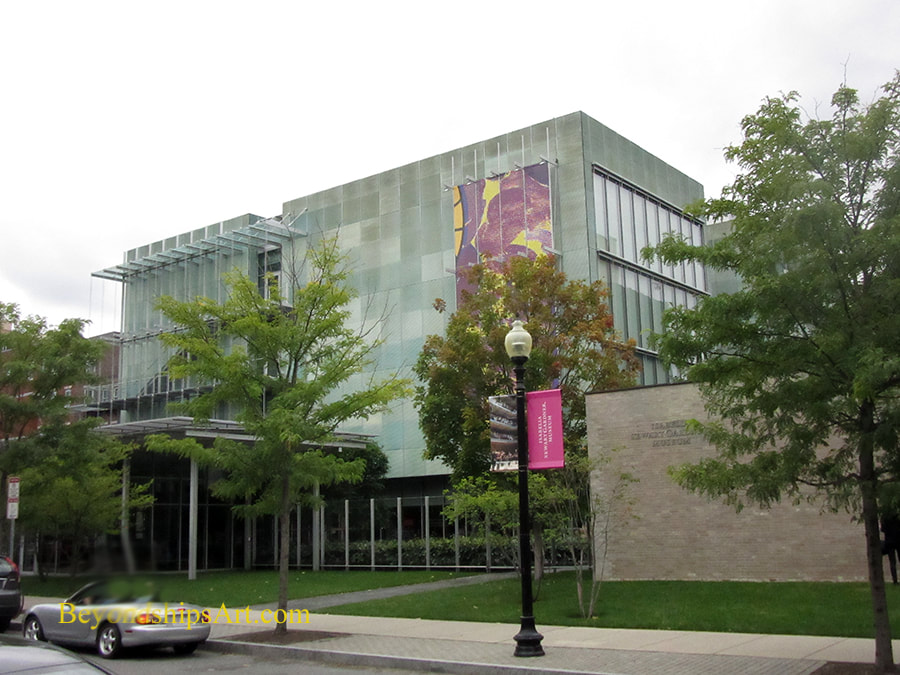|
Located in the Fenway section of Boston, the Isabella Stewart Gardner Museum is the home of a superb collection of American and European art. It is housed in an architecturally interesting historic building. As a result, it is one of the most popular museums in this city of numerous museums.
The museum was created by Isabella Stewart Gardner. Born into a well-to-do family in New York City in 1840, Isabella married Jack Gardner in 1860. The couple settled in Boston, Jack's home town. After the death of their young child from pneumonia, the Gardners began traveling in Europe where they became part of intellectual and artistic circles. They continued such pursuits when they returned to Boston. At first, Isabella began collecting art and rare books on a small scale. However, after she received a large inheritance from her father, she greatly increased her collecting. With the aid of her art adviser Bernard Berenson, Isabella collected old master paintings, ancient sculptures, rare books, tapestries and furniture. By the turn of the century, the collection became too large for their house on Beacon Hill and so the Gardners began to consider building a museum to house the collection. In 1898, Jack suddenly died of a stroke. However, Isabella decided to carry on with the idea of building a museum. She purchased land in the then-undeveloped Fenway area of Boston. She also hired the architect William T. Sears to design a new building based on the designs of 15th century Venetian palaces. Isabella took a hands-on approach to the project, visiting the construction site daily and voicing her ideas. She also purchased elements from European Gothic and Renaissance buildings and had them shipped to Boston to be incorporated into the new building. Visitors sometimes think that this building, known as “Fenway Court” was created to be another Gilded Age palace like the “cottages” at Newport. (See article). However, it was never intended to be a private residence. Although once it was completed, Isabella moved into quarters on the fourth floor, the bulk of the building has always been three floors of galleries around a central courtyard. The galleries, of course, are not arranged as in most museums. Rather, paintings and sculpture mix with antique furniture and decorative arts. There are few signs and labels. The lighting is kept low. Thus, the atmosphere is more akin to that of a private residence even though no one ever lived in the galleries. The museum opened to the public in 1903. For the next two decades, Isabella made it a center for artists, musicians and intellectuals to gather. When she died in 1923, her will included an endowment for the museum as well as instructions that the galleries remain the way that she had arranged them and that nothing be bought for or sold from the collection. In 1990, a change was made to the collection when the museum was the victim of perhaps the most notorious art theft of modern times. Two men disguised as police officers stole 13 works of art from the museum. These included Vermeer's “The Concert,” Rembrandt's “Christ In a Storm on the Sea of Gallae,” a Manet and drawings by Degas. Strangely, other monetarily more valuable works were not taken. The theft has never been solved. Empty frames still hang in the galleries in hope that the stolen works will someday be recovered. The museum was expanded in 2012 with the addition of a new wing. Designed by Renzo Piano, the new wing has space for temporary exhibitions, a music performance area, a cafe, shop, and administrative offices. A modern building that makes extensive use of glass, it was designed to be subservient rather than compete with the historic palace. The collection assembled by Isabella includes 7,500 works of art, 1,500 rare books and thousands of archival objects. Highlights include works by Raphael, Michelangelo, Rembrandt, Botticelli, Manet, Degas, and Whistler. There are several works by John Singer Sargent who was a friend of Isabella and who painted in the museum. The museum is a short walk from the Boston Museum of Fine Arts. Visitors who go to both museums on the same day can obtain a discount on admission. For information about visiting, see the Isabella Stewart Garner Museum's website. For more about visiting Boston
See our Boston profile and guide |
Above: The original building surrounds a covered courtyard with living plants and statues.
Below: The New Wing. Above: One of several portraits of Mrs. Gardner by John Singer Sargent.
Below: Sargent's "El Jaleo" was one of the paintings collected by Mrs. Gardner. Above: Raphael's portrait of Tommaso Inghiromi.
|
Places to see art - - Boston - United States - - Isabella Stewart Gardner Museum




